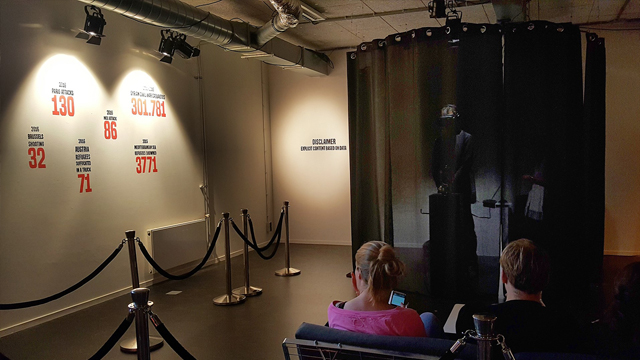Sterile numbers can easily obscure the human lives behind reported death tolls from war, drone strikes, and terrorism. Iranian virtual reality artist Ali Eslami, who in the past created something of a vaporwave Valhalla, is working to change that with his latest piece, DeathTolls Experience.
The experience, previewed here, which recently won the DocLab Immersive Non-Fiction Award at the IDFA Festival in Amsterdam, places the user in virtual reality amongst body bags which populate six environments, representing six mass death events spanning from Europe to the Middle East.
Videos by VICE
Drawing on his background in data visualization and research on cognitive science, Eslami says DeathTolls explores “new pathways in the perception of data,” creating a vehicle for empathy in processing otherwise “meaningless datasets.” He says he hopes to break down the mental filters that are formed from overexposure to massive amounts of death happening around the world.

“I couldn’t fit 71 bodies inside the truck because otherwise the user in VR couldn’t move,” Eslami says of his VR representation of refugees who were found suffocated to death in Austria. “When you see this in VR, you feel the presence of all these bodies. That’s where the impact comes from,” Eslami explains to The Creators Project. He says the level of immersion in the grim, 8-minute-long simulation forces some users to remove the headset before getting to the end.
“It was so mind-blowing. Some people were crying inside the headset,” Eslami says.
An earlier version of the piece uses a video game-style interface, presenting photos and statistics in popup windows as the user “plays” through the scene. After getting a VR headset in 2015, Eslami redesigned the entire project based on that medium.

Sourced from Wikipedia, data on death tolls of six events is displayed near the VR experience.
“It wasn’t natural to put the numbers inside the experience. It feels really phony,” Eslami says. “I thought about doing a voiceover to tell you about the numbers, but that’s also even more horrible. Because in VR you have to let go of most of the things you’re used to doing in gaming and filmmaking. I felt that it should be super objective and natural.”

Representation of 3771 refugees drowned in the Mediterranean Sea in 2015.
Stitching the datasets together across continents, the experience moves from mass shootings in Europe to refugee drownings in the Mediterranean Sea, ending with civilian casualties of the Syrian civil war beginning in 2011. As the user makes the journey southeast, the death tolls visibly increase and the environments become more sprawling. Eslami says that gradually growing the numbers helps people make more sense out of the staggering amount of death.
The artist intentionally begins the experience in Europe, saying “It works to bring them from Europe where the media is very focused. If you see the highlights of 2016, it’s mostly European massacres, not the things that are happening in Syria.”
Eslami is also skeptical of the media’s tendency to focus on individual victims, like the now-viral video of shellshocked Syrian child Omran Daqneesh, saying that this only narrows the perception of what is really happening.

The last scene of the experience confronts the viewer with 30 massive towers filled with 10,000 body bags each, representing the 300,000 civilian casualties of the Syrian civil war since 2011. “I usually conceptualize big numbers with the capacity of stadiums. The perceptual set of architecture helps us deal with the scale,” Eslami tells The Creators Project.
“The problem is, because it’s always happening day by day and it’s incrementally growing, many people don’t even know about what generally happened in the past few years,” Eslami tells The Creators Project. “They know, ‘OK, some people are dying there day by day,’ but when you put them all together, that’s when it gets horrible.”
Eslami has submitted DeathTolls Experience to several festivals including Sundance, and next year has a planned release for Vive and Oculus in 2017.
Related:
Is Virtual Reality the Future of Journalism?
The UN’s First Virtual Reality Documentary Puts You Inside a Syrian Refugee Camp




